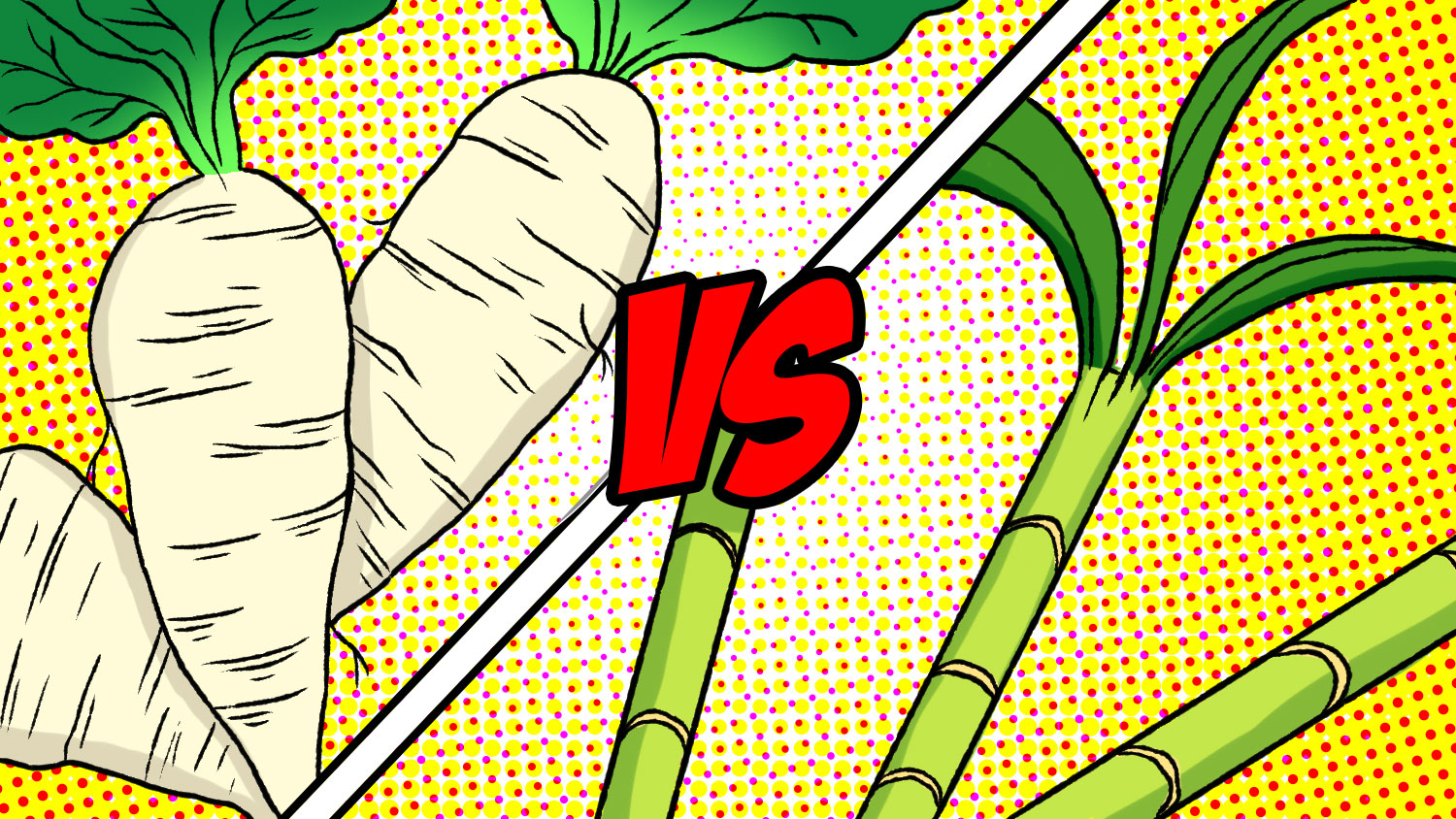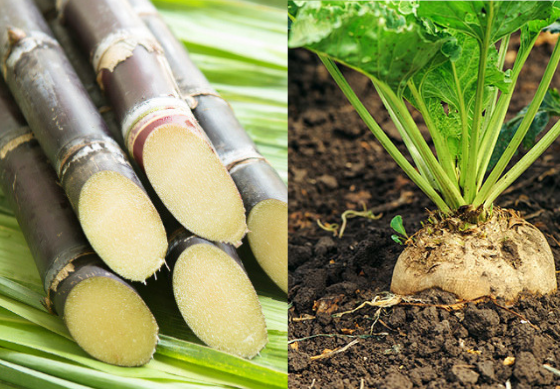Sugar beet vs sugar cane: Evaluating their performance under climate change scenarios
Unloading Sugar Beet Vs Sugar Cane: Necessary Details on Their Usages and Effect On the Sugar Market
The distinction in between sugar beet and sugar cane plays an essential duty in the international sugar market. Each plant has one-of-a-kind growing techniques and geographical choices. Their handling approaches vary significantly, affecting dietary profiles and economic implications. Environmental sustainability is ending up being increasingly relevant in customer options. Comprehending these factors can light up the intricacies of the sugar sector and its future direction. What stays to be checked out are the shifting fads that might improve this landscape.
Overview of Sugar Beet and Sugar Cane
Sugar beet and sugar cane are two primary resources of sucrose, each grown in distinct environments and possessing special qualities. Sugar beet, a root veggie, prospers in temperate environments, primarily in Europe and The United States And Canada. It is usually collected in the loss and goes through processing to essence sugar from its high sucrose material. On the other hand, sugar cane is an exotic grass that prospers in warmer regions, such as Brazil and India. Its high stalks are harvested year-round, supplying a continual supply of sugar.The sucrose drawn out from sugar cane is usually perceived as having a more complicated flavor account compared to that from sugar beet. Both sources contribute significantly to the international sugar market, influencing costs and availability. Understanding their distinctions is crucial for stakeholders in farming, food production, and business economics, as these plants play a critical function in food systems worldwide.
Cultivation Practices and Geographic Circulation
Both sugar beet and sugar cane are important sources of sucrose, their cultivation techniques and geographic circulation vary substantially. Sugar beet prospers in warm environments, particularly in Europe and North America, where its cooler expanding seasons improve origin advancement. Farmers frequently practice plant rotation and make use of advanced farming innovations to make the most of yields, favoring well-drained, productive soils.In comparison, sugar cane flourishes in tropical and subtropical areas, with Brazil, India, and China being the leading producers. Its cultivation calls for warmer temperature levels and adequate rains, making irrigation essential in drier locations. Sugar cane is commonly expanded in monoculture systems, which can result in dirt depletion if not managed sustainably. In addition, harvesting methods differ; sugar cane is often cut by hand or maker, while sugar beet is commonly gathered using specific equipment. These geographical and farming variants substantially influence the international sugar market and regional economic climates.
Processing Techniques and Production Methods
The processing approaches and manufacturing strategies for sugar beet and sugar cane highlight substantial distinctions that influence the end product's top quality and qualities. Sugar beetroots undergo a simple process, where they are gathered, washed, and cut right into thin chips prior to being subjected to hot water extraction to dissolve the sugar. The resulting juice is after that made clear, vaporized, and crystallized to generate granulated sugar.Conversely, sugar cane handling involves crushing the stalks to extract juice, complied with by a collection of home heating and boiling actions. This approach includes the elimination of impurities and further evaporation, leading to crystallization. Additionally, sugar cane handling commonly highlights the production of molasses and bagasse, which can be used for power or other products.These differed strategies show not just the distinctions in the resource materials yet likewise their implications for efficiency, sustainability, and last sugar characteristics out there.
Nutritional Profiles and Health And Wellness Implications
An evaluation of the dietary profiles of sugar beet and sugar cane reveals unique distinctions in their nutrient make-up. Each resource uses unique health advantages that can influence dietary options. Comprehending these variants is important for making informed decisions concerning sugar consumption and total wellness.

Nutrient Structure Contrast
Nutritional accounts of sugar beet and sugar cane disclose distinct differences that can influence wellness results. Sugar beets include higher levels of important nutrients such as fiber, potassium, and magnesium, which contribute to digestive system health and wellness and cardio feature. In contrast, sugar cane primarily provides sucrose, with very little nutritional value past power arrangement. The fiber material in sugar beets aids in managing blood sugar level levels, while sugar cane lacks this benefit. In addition, sugar beetroots have a lower glycemic index contrasted to sugar cane, which might be advantageous for people taking care of blood sugar level. These variations in nutrient structure emphasize the value of considering the source of sugar, specifically for those conscious of their dietary selections and overall health.
Health Conveniences Summary
Wellness advantages stemmed from sugar beet and sugar cane intake differ substantially because of their differing nutritional accounts. Sugar beets are rich in essential nutrients, including dietary fiber, vitamins, and minerals, specifically folate and potassium. This make-up can support digestive health and wellness, improve cardiovascular feature, and aid in blood sugar law. On the other hand, sugar cane primarily offers a source of carbohydrates and power, with fewer minerals and vitamins. Nonetheless, it consists of anti-oxidants, which may help battle oxidative stress and anxiety and inflammation. Sugar beet vs sugar cane. The wellness implications of eating these sugars additionally depend upon their types-- whole foods versus fine-tuned sugars-- affecting general advantages. Inevitably, moderation is vital, as extreme intake of either can bring about health problems, highlighting the value of well balanced consumption
Financial Effect on Local and International Markets
Both sugar beet and sugar cane offer as crucial resources of sugar, their financial impacts on regional and global markets vary significantly. Sugar cane largely prospers in exotic climates, making it a staple in nations like Brazil and India, where the farming infrastructure is heavily geared in the direction of large-scale vineyards. This contributes to significant export earnings and employment chances in these areas. Alternatively, sugar beet is usually grown in warm areas, specifically in Europe and The United States And Canada, where its manufacturing supports neighborhood economies via smaller-scale farming and processing industries.The worldwide sugar market is influenced by tolls, trade agreements, and subsidies, which can favor one sort great site of sugar over the various other. Changes in rates likewise impact both neighborhood farmers and worldwide markets, causing differing financial security in regions depending on sugar manufacturing. As a result, the financial landscape shaped by sugar beet and sugar cane is complex and multifaceted, mirroring broader farming trends.
Ecological Considerations and Sustainability
The environmental considerations surrounding sugar beet and sugar cane production highlight significant differences in land use, water intake, and carbon impacts. Understanding these factors is crucial for reviewing the sustainability of each crop. The impacts of growing methods on environments and resources have to be thoroughly analyzed to educate future farming decisions.
Land Usage Impacts
When reviewing the land use influences of sugar beet and sugar cane cultivation, it becomes apparent that each crop provides unique environmental factors to consider and sustainability obstacles. Sugar beet, typically expanded in pleasant areas, frequently needs considerable land conversion in locations formerly used for varied crops, potentially resulting in decreased biodiversity. In comparison, sugar cane is primarily cultivated in tropical regions, where its considerable land requirements can result in logging and habitat loss. Furthermore, sugar cane fields might displace food crops, elevating worries regarding food safety and security. Both plants add to soil destruction through monoculture techniques, requiring sustainable agricultural methods. Ultimately, the land usage ramifications of both sugar beet and sugar cane cultivation emphasize the demand for equilibrium in between financial feasibility and ecological stewardship.
Water Intake Differences
Water usage stands for an essential element in evaluating the sustainability of sugar beet and sugar cane production. Sugar cane generally needs substantially much more water than sugar beet, primarily as a result of its development conditions in exotic environments where irrigation is frequently required. Alternatively, sugar beet is primarily cultivated in pleasant areas and generally depends a lot more on rainfall, making it less depending on substantial watering systems. This difference in water use effects local water sources and can result in problems over water scarcity. The efficiency of water use in sugar beet farming usually results in reduced total water impacts compared to sugar cane. Understanding these differences is important for reviewing the environmental implications and sustainability of these 2 sugar sources.
Carbon Impact Evaluation
Examining the carbon impact of sugar beet and sugar cane production is necessary for recognizing their total environmental influence. Sugar beet cultivation usually causes a reduced carbon impact contrasted to sugar cane, largely because of the reduced dependence on fossil fuels for handling and transportation. Additionally, sugar beet is typically grown in pleasant environments, minimizing the demand for substantial watering and lowering greenhouse gas exhausts. On the other hand, sugar cane farming normally includes greater energy consumption, especially in tropical areas, where cultivation and processing can be resource-intensive. Land-use adjustments connected with sugar cane development can worsen carbon exhausts. Inevitably, both plants present unique sustainability challenges that need to be dealt with to reduce their ecological footprint in the international sugar market.
Future Patterns in the Sugar Sector
Just how will the sugar sector evolve in the coming years? Sector professionals anticipate a number of transformative fads shaping its future. A significant shift towards sustainability is expected, driven by heightened customer understanding and regulatory pressures. This will likely bring about boosted financial investments in eco-friendly production approaches, benefiting both sugar beet and sugar cane growers.Additionally, technical advancements, such as precision farming and biotechnology, are expected to boost crop returns and decrease resource consumption. The sector might likewise see a surge in alternative sugar, as consumers increasingly look for healthier options.Moreover, the global demand for sugar is predicted to fluctuate, affected by altering nutritional choices and economic problems. As countries apply stricter sugar taxes, manufacturers will need to adapt their strategies to remain competitive. In general, the sugar industry appears positioned for considerable evolution, stressing sustainability and technology in feedback to market characteristics.
Often Asked Inquiries
What Are the Key Distinctions in Taste Between Sugar Beet and Sugar Cane?
The major differences in preference between sugar beet and sugar cane can be refined. Sugar cane is typically called having a richer, extra complex taste, while sugar beet has a tendency to be rather milder and much less aromatic.
Exactly How Do Sugar Beet and Sugar Cane Affect Cooking Recipes Differently?
The distinctions between sugar beet and sugar cane in cooking recipes mainly exist in their dampness web content and taste profiles - Sugar beet vs sugar cane. Sugar cane usually boosts caramelization, while sugar beet has a tendency to look at this web-site generate a much more neutral sweetness
Can Sugar Beet and Sugar Cane Be Used Reciprocally in Cooking?
Sugar beet and sugar cane can commonly be utilized mutually in cooking; nevertheless, subtle differences in flavor and appearance may affect the final result of meals, depending on the check my site certain dish and wanted outcomes.

What Are the By-Products of Processing Sugar Beet and Sugar Cane?
The spin-offs of processing sugar beet consist of molasses, pet feed, and biofuels, while sugar cane processing returns bagasse, molasses, and ethanol (Sugar beet vs sugar cane). Both plants add significantly to various markets beyond sugar manufacturing
Exactly How Do Sugar Beet and Sugar Cane Add To Biofuel Production?
Sugar beet and sugar cane serve as substantial sources for biofuel production. Their deposits, after sugar extraction, can be transformed into bioethanol, adding to sustainable energy campaigns and decreasing reliance on fossil gas in different regions.